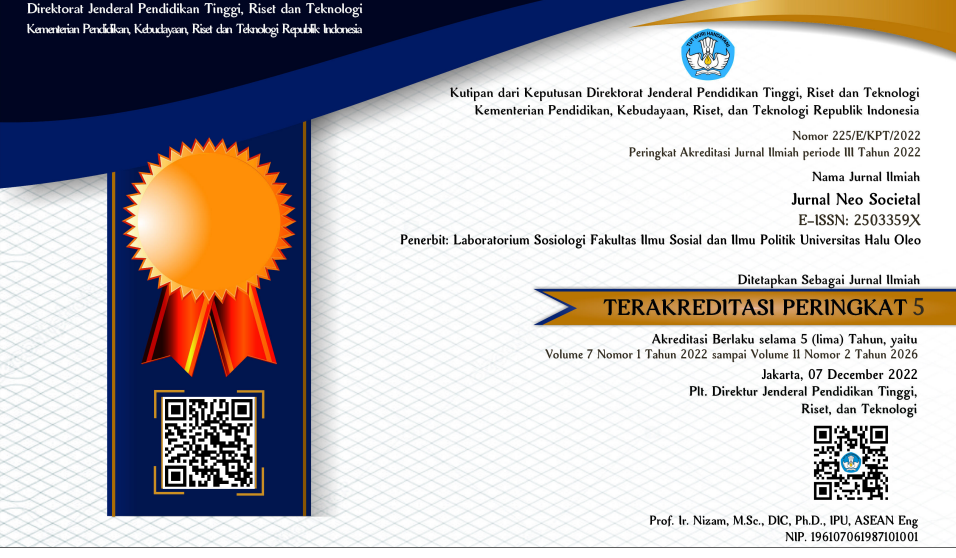KAJIAN EKSISTENSI NILAI-NILAI DAN MAKNA MOTIF KERAJINAN KAIN TENUN TRADISIONAL ETNIS KULISUSU
Keywords:
Nilai,, Makna, Motif Tenun, Etnis KulisusuAbstract
The purpose of this research is to (1) To analyze the process of making Kulisusu ethnic woven fabrics (2) To analyze the meaning of the motifs contained in the traditional woven crafts of the Kulisusu ethnic (3) To analyze the zzeducational values contained in the traditional weaving crafts of the Kulisusu ethnic. This research includes qualitative research and uses a type of descriptive approach, data collection is done by using the method of observation, interviews, documentation. The results showed that the process of making Kulisusu ethnic woven fabric crafts consisted of 9 stages, namely 1) materials; 2) tools 3) traditional rituals 4) drawing motifs: 5) spinning threads; 6) sorting yarn (pouluri); 7) Arranging yarn (Lopo); 8) tying the motifs on the warp; 9) weave (Mohoru). The meaning of the motif contained in the woven fabric of the Kulisusu ethnicity is that the vertical motif means the relationship between humans and the creator; horizontal motives that are meaningful about human relationships with other humans; and natural motifs that are meaningful about the relationship between humans and nature.The educational values contained in the traditional weaving crafts of the Kulisusu ethnicity are religious values, honest values, love for the motherland and social care values and responsibility values.
References
Afif Syakur. Wira Usaha dan Manajemen Desain. (Yogyakarta: Balai Kajian Sejarah dan Nilai Tradisional, Depbudpar, 2007), hal 26.
Elvida, M. N. (2015). Pembuatan Kain Tenun Ikat Maumere Di Desa Wololora. Jurnal Holistik, Tahun VIII(16), 1–22. https://doi.org/https://ejournal.unsrat.ac.id/index.php/holistik/article/view/9997
I Gusti Ayu Purnamawati. (2016). Perlindungan Hukum Indikasi Geografis terhadap Kerajinan Tradisional untuk Penguatan Ekonomi Wilayah. 11(June), 32–46. https://doi.org/DOI: https://doi.org/10.15294/pandecta.v11i1.5035
Jamiludin. (2021). Kerajinan Tenun Pada Masyarakat Muna (Kasus Peranan Modal Manusia dan Modal Sosial dalam Reproduksi Budaya Tenun di Kabupaten Muna). OSF Preprints, 1–25. https://doi.org/DOI:10.31219/osf.io/4bksf
Melamba, B. (2012). Sejarah dan Ragam Hias Pakaian Adat Tolaki di Sulawesi Tenggara. MOZAIK: Jurnal Ilmu Humaniora, 12(2), 193–209. https://doi.org/http://journal.unair.ac.id/MZK@sejarah-dan-ragam-hias-pakaian-adat-tolaki-di-sulawesi-tenggara-article-10216-media-19-category-8.html
Miles, Mathew B & A Michael Huberman.(1992).Analisis Data Kualitatif.Jakarta.: UI Press
Ni Ketut Sri Astati Sukawati. (2020). Tenun Gringsing Teknik Produksi, Motif Dan Makna Simbolik. Jurnal Ilmiah Vastuwidya, 3(1), 60–81. https://doi.org/10.47532/jiv.v3i1.101
Panjaitan, Sitong dkk. 2021. Eksplorasi Etnomatematika Kain Tenun Songket Suku Melayu Sambas.AlphaEuclidEdu. Vol 2 (1), 24
Prayitno, Teguh.2010. Mengenal Produk Nasional Batik Dan Tenun. Jawa tengah: Alpirin
Setem, W., & Mudana, I. W. (2021). Penyusunan Ensiklopedia Bidang Seni Lukis Klasik, Seni Ukir, Dan Tekstil Di Bali. Brikolase : Jurnal Kajian Teori, Praktik Dan Wacana Seni Budaya Rupa, 13(2), 22–42. https://doi.org/10.33153/brikolase.v13i2.3763
Sila, I. N. (2013). Kajian Estetika Ragam Hias Tenun Songket Jinengdalem, Buleleng. Jurnal Ilmu Sosial Dan Humaniora, 2(1), 158–178. https://doi.org/10.23887/jish-undiksha.v2i1.1311
Slamet, A. (2017). Corak Motif Flora Sarung Tenun Buton Sebagai Pembelajaran Berbasis Lingkungan (Studi Etnobotani Terhadap Masyarakat Buton). Seminar Nasional Pendidikan Biologi Dan Saintek II, 2, 571–577. https://doi.org/http://hdl.handle.net/11617/9380
Sugiyono. 2013. Metode Penelitian Kuantitatif, Kualitatif, dan R&D. Bandung: Alfabeta
Yuliati, Qiqi Zakiyah & Rusdiana. 2014. Pendidikan Nilai Kajian Teori dan Praktik di Sekolah. Bandung. Pustaka Setia
Downloads
Published
How to Cite
Issue
Section
License
Copyright (c) 2023 La Ode Monto Bauto, Sulisvia, Jamiluddin, Dewi Anggraini

This work is licensed under a Creative Commons Attribution 4.0 International License.













